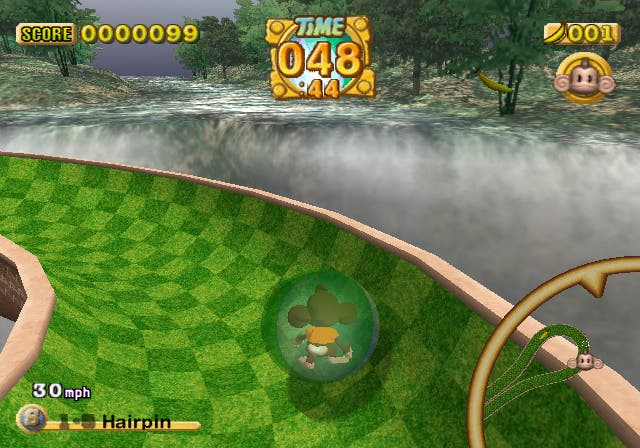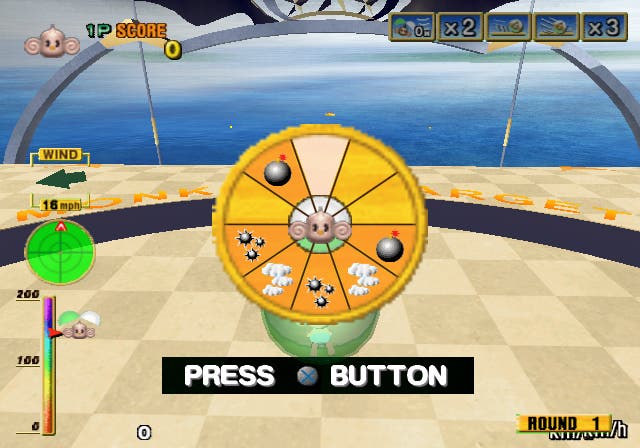Super Monkey Ball Deluxe
A question of port.
When I review updates of old games, I often forget to describe what they're actually like. Not this time! In Monkey Ball you control a monkey in a ball, and the idea is to navigate a course of bumps, gaps, moving tiles and other obstacles to reach the finishing line. If you fall off into the abyss below or run out of time, you fail. You're also expected to master the eccentricities of the game-camera, which twitches playfully as you make minor adjustments, and the impact it has on the orientation of the controls - refusing to offer you the optimum angle for view or control unless you master its behaviour. Monkey Ball's other claim to fame is its mini-games, the best of which are based on bowling and parachuting. It used to be on the GameCube; now it's on PS2 and Xbox. With that out of the way...
Much like my Mum used to say when my sister passed a music exam on the same day that I rode my bike into a cat, we love all of our children differently. Some of my favourite children (and by children I mean games; they're about as close as I'm going to get) appeal to me not just because they are ultraviolent or brilliantly written or let me do things in genuinely interesting new ways, but because they allow me to extort more entertainment by playing around with the fundamentals of the world
What I mean by that is that some worlds are so well designed that you can make your own fun - by finding ways to do things more efficiently, or simply playing around with the rules that govern them. Take rocket or grenade-jumping or speed-running in Quake 1 for example - all possible because the rules are so consistent and the levels weren't foolproofed against the player's advanced interpretation. Perhaps the best example at the moment is PSP maze-puzzler Mercury, which is actually designed to be exploited - by using the friction between blob and environment to uncover wicked shortcuts.
The cult of Super Monkey Ball will immediately know what I'm talking about. Anybody who can exploit the physics to shortcut an entire maze, anybody who can ride the 0.1 bar from end to end on the guitar strings level (or better), anybody who's played the Master levels - these people will be able to appreciate the absolute joy of experimenting with a world. It's actually quite a rare thing for a game design to be so principled throughout. Monkey Ball as-was is as principled as they come - which is why the Deluxe version is going to be criticised to a certain extent.
The first GameCube game, Super Monkey Ball, was a lot more hardcore than Deluxe. The Cube simply offers much better analogue stick control. Both PS2 and Xbox have a sort of dead zone around the centre of the stick where actual movement isn't registered, so you wind up nudging the stick further from the centre point to find it and - whoops! - you've over-adjusted and gone over the edge. This is particularly acute on the PS2, because your thumb has to travel further to achieve the same degree of movement you get from smaller motions on the Cube and Xbox, and the grip on top of the PS2 stick is so awful (once your sweaty mitts do their work over an extended period) that in doing so you tend to lose absolute control.

The Xbox stick is taller with a thumb indentation, so it's less of a problem, but purists are going to immediately dislike both versions for several reasons. Most notably, the PS2 version has no replay-save or widescreen mode (Xbox has both), the music cuts out on the transitions between levels (irritating), the graphics are much worse (no reflective or particle effects, 2D sprites instead of 3D models for the clouds and bombs in Monkey Target, far more jagged edges), and the frame rate is weak compared to Xbox or Cube. Xbox looks a lot sharper, but both versions have problems with actual changes to the levels - on the guitar strings level for example, the barrier that rises to stop you reaching the strings now comes up faster, and the higher-resolution Xbox texturing means that it's incredibly difficult to use the tiles to judge the position of the 0.1 string by sight.
Those of you who've been skimming will now be wondering: who the bloody hell cares? Well, I do. And SEGA's chucked in a few new stages as well as collating everything from SMBs 1 and 2, so it seems fair to infer they want more of my money. For me, the Cube original is still the purist's choice, but you will be able to adapt to this discipline after a while and, who knows, maybe you'll have some fun exploring the subtleties that distinguish each version from one another. I did. (Hence the lack of children.)
Some people will simply enjoy the chance to play it for the first time, and won't care about dead zones on analogue sticks and whether the bridge moves too fast on one stage out of more than 200. They are likely to want to be told things like this: by offering both story and challenge modes, SEGA allows players to choose between picking their own moderately difficult path through the game, avoiding really tough levels en-route with unlimited retries (story mode), or by steeling themselves to overcome the linear option (challenge mode) through sheer bloody-minded determination and many hours of Practice-mode-play.

As with any indiscriminate compilation, there's a lot of padding, and the challenge mode's Beginner setting demonstrates this most aptly, with many of its 40 stages far too straightforward and unexciting. On the other hand, there's far more quality here than in either of its forebears, too, and that's borne out by the many hours that it's fun to spend in Practice mode learning how to complete its more advanced stages.
There's no change to the camera, mind, which is always controlled by the game and not the player. It twitches as you make adjustments to your monkey's position, and its orientation makes a difference to the directional movement registered by the analogue stick, so learning how to manipulate it effectively is crucial if you ever want to become very good at the game. Some people complain about the camera - I think it's one of the reasons Monkey Ball is such a delight, and I'm willing to bet, in light of some of the changes that are obviously geared toward accessibility, that SEGA has tried changing it and decided it's simply better this way.
Anyway, it's time to divide the two camps - hardcore and casual - and thankfully there is a point where the newcomer and the ultra-hardcore will unite without reviewer-sponsored segregation. What's lovely is that Monkey Ball knows this and wants to ingratiate itself. There are levels that are simply too hard to complete without rudimentary exploitation of the physics engine - the lattice of triangular holes that you can only realistically bridge by barrelling along and trying to bounce off the narrow strands of solid ground between them, for example. When you figure that out, you start thinking about other possibilities.

That said, everyone enjoys the mini-games, which are now unlocked by default - a decision that reflects, as does the Story mode, the developer's determination to open the game up to a much larger audience. The quality may vary. Some are various measures of "classic", offering immediate appeal (Monkey Target, Fight, Golf and Bowling spring to mind), while others are at best mediocre (Monkey Boat and Tennis, for example) and are unlikely to survive a few inquisitive prods the first time you load the disc. Like the single-player mode, some have hidden depths - the highest-scoring areas in Monkey Target can only be reached by deliberately stalling at high altitude so you come in slow with the camera staring down at you. The very idea encourages you to play around.
Of course the idea with Deluxe is that even if that's beyond you so much has been brought together that there's enough to entertain regardless.
To bring myself all together, Monkey Ball is something you need to own, but this may not be the version for you. If you haven't played it before and you liked the sound of the first half of the review, get the first Cube game. If you haven't played it before and you just want to play mini-games and duck around a few mazes now and then, get the Cube sequel or get this - and pick the Xbox version over the PS2 if the option's available to you. If you're just reading to compare notes, get the hell out of here - unless you have some burning desire to play spot the difference, neither the £25 PS2 version or the £30 Xbox version are worth adding to your stack of Monkeys.
And if you're SEGA, you can have a slapped wrist for the lack of high score and replay uploads - particularly on Xbox Live. If you'd done that, this would be a blanket recommendation.

